Developer Guide
- Acknowledgements
- Setting up, getting started
- Design
- Implementation
- Documentation, logging, testing, configuration, dev-ops
- Appendix: Requirements
- Appendix: Instructions for manual testing
- Appendix: Effort
- Appendix: Planned Enhancements
Acknowledgements
- This project is based on the AddressBook-Level3 project created by the SE-EDU initiative.
- This project utilises the PrettyTime library.
Setting up, getting started
Refer to the guide Setting up and getting started.
Design
.puml files used to create diagrams in this document can be found in the diagrams folder. Refer to the PlantUML Tutorial at se-edu/guides to learn how to create and edit diagrams.
Architecture
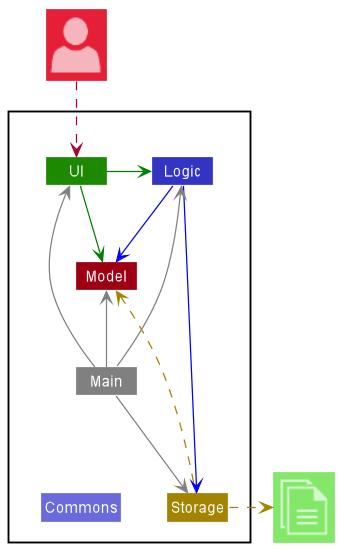
The Architecture Diagram given above explains the high-level design of the App.
Given below is a quick overview of the main components and how they interact with each other.
Main components of the architecture
Main has two classes called Main and MainApp. It is responsible for,
- At app launch: Initializes the components in the correct sequence, and connects them up with each other.
- At shut down: Shuts down the components and invokes cleanup methods where necessary.
Commons represents a collection of classes used by multiple other components.
The rest of the App consists of four components.
-
UI: The UI of the App. -
Logic: The command executor. -
Model: Holds the data of the App in memory. -
Storage: Reads data from, and writes data to, the hard disk.
How the architecture components interact with each other
The Sequence Diagram below shows how the components interact with each other for the scenario where the user issues the command delete-client 1.
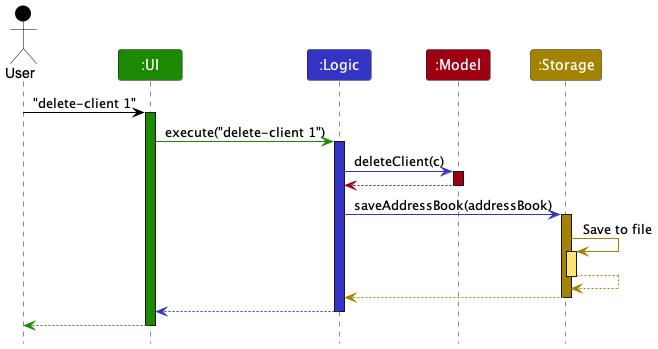
Each of the four main components (also shown in the diagram above),
- defines its API in an
interfacewith the same name as the Component. - implements its functionality using a concrete
{Component Name}Managerclass (which follows the corresponding APIinterfacementioned in the previous point).
For example, the Logic component defines its API in the Logic.java interface and implements its functionality using the LogicManager.java class which follows the Logic interface. Other components interact with a given component through its interface rather than the concrete class (reason: to prevent outside component’s being coupled to the implementation of a component), as illustrated in the (partial) class diagram below.
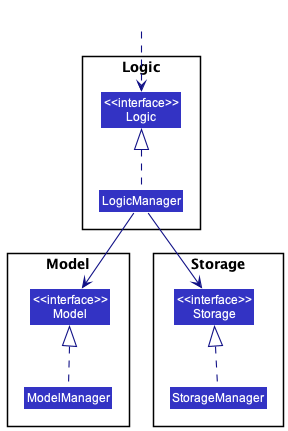
The sections below give more details of each component.
UI component
The API of this component is specified in Ui.java
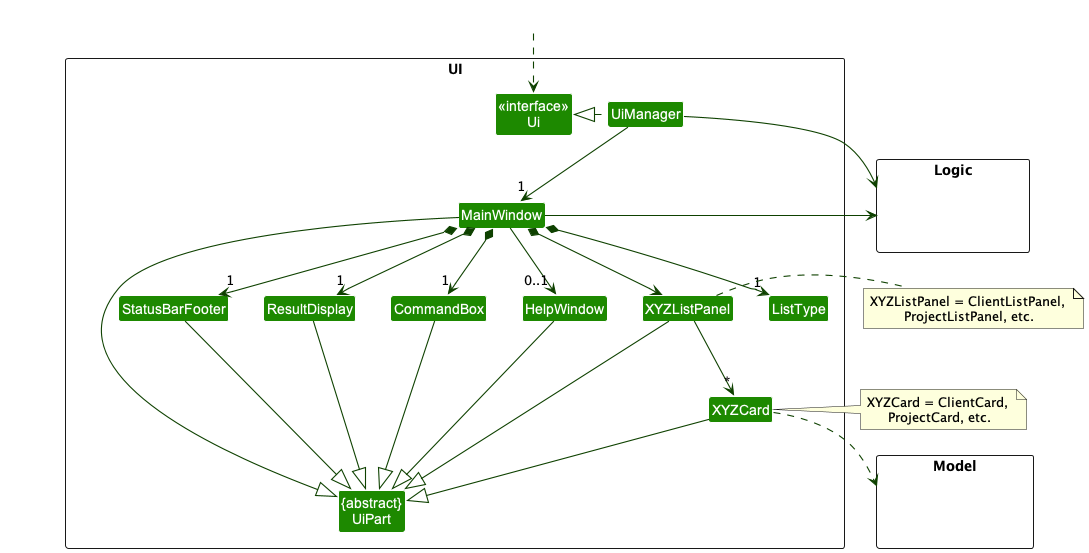
The UI consists of a MainWindow that is made up of parts e.g.CommandBox, ResultDisplay, StatusBarFooter etc. All these, including the MainWindow, inherit from the abstract UiPart class which captures the commonalities between classes that represent parts of the visible GUI.
The UI component uses the JavaFX UI framework. The layout of these UI parts are defined in matching .fxml files that are in the src/main/resources/view folder. For example, the layout of the MainWindow is specified in MainWindow.fxml
The UI component,
- executes user commands using the
Logiccomponent. - listens for changes to
Modeldata so that the UI can be updated with the modified data. - keeps a reference to the
Logiccomponent, because theUIrelies on theLogicto execute commands. - depends on some classes in the
Modelcomponent, as it displaysClient,ProjectandTagMappingobjects residing in theModel.
Logic component
API : Logic.java
Here’s a (partial) class diagram of the Logic component:
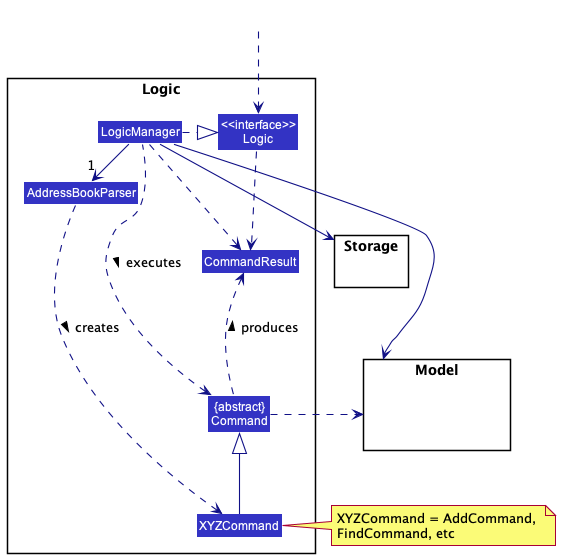
How the Logic component works:
- When
Logicis called upon to execute a command, it uses theAddressBookParserclass to parse the user command. - This results in a
Commandobject (more precisely, an object of one of its subclasses e.g.,AddCommand) which is executed by theLogicManager. - The command can communicate with the
Modelwhen it is executed (e.g. to add a client). - The result of the command execution is encapsulated as a
CommandResultobject which is returned back fromLogic.
The Sequence Diagram below illustrates the interactions within the Logic component for the execute("delete-client 1") API call.
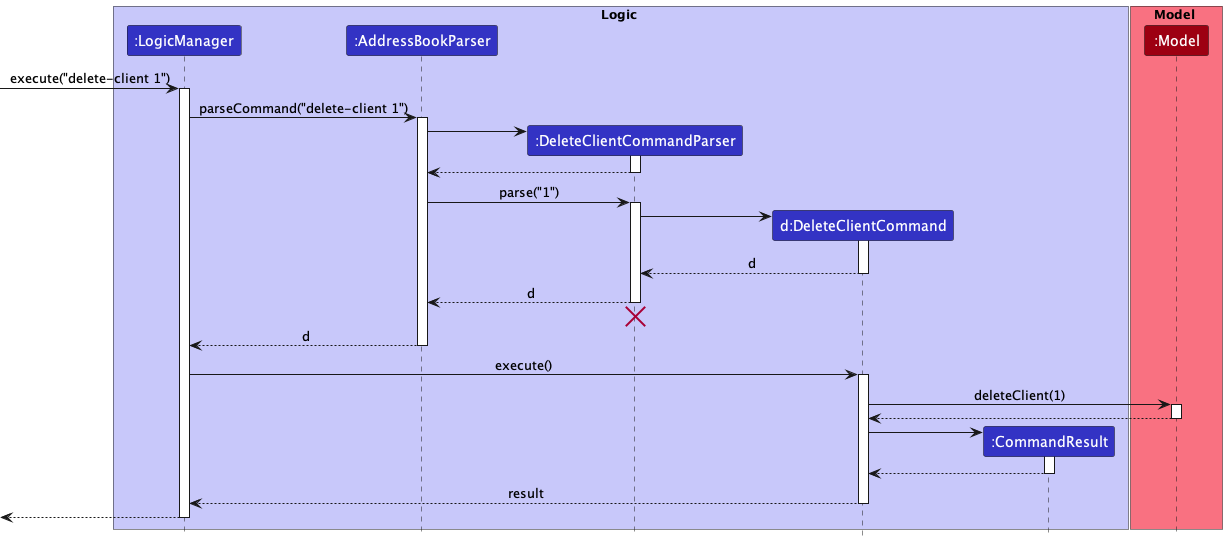
DeleteClientCommandParser should end at the destroy marker (X) but due to a limitation of PlantUML, the lifeline reaches the end of diagram.
Here are the other classes in Logic (omitted from the class diagram above) that are used for parsing a user command:
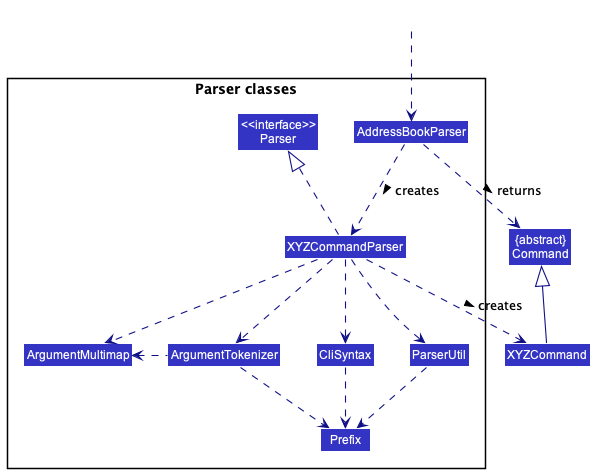
How the parsing works:
- When called upon to parse an user input, the
AddressBookParserclass creates anXYZCommandParser(XYZis a placeholder for the specific command name e.g.,AddClientCommandParser) which uses the other classes shown above to parse the user command and create aXYZCommandobject (e.g.,AddClientCommand) which theAddressBookParserreturns back as aCommandobject. - All
XYZCommandParserclasses (e.g.,AddClientCommandParser,DeleteClientCommandParser, …) inherit from theParserinterface so that they can be treated similarly where possible e.g, during testing.
Model component
API : Model.java

The above diagram shows a quick overview of the Model component, while the three diagrams below expand on the relationships between the ModelManager, AddressBook and the three entities it stores.
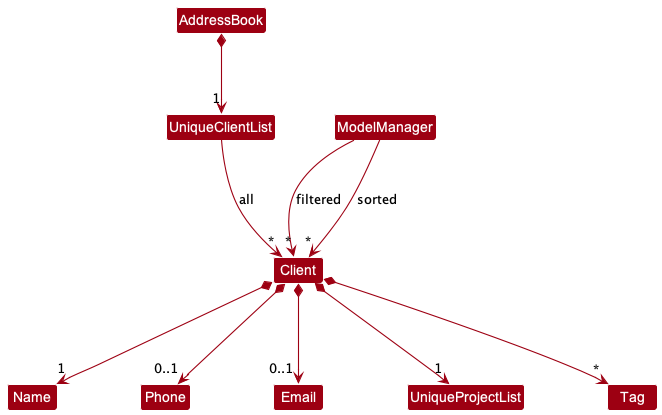
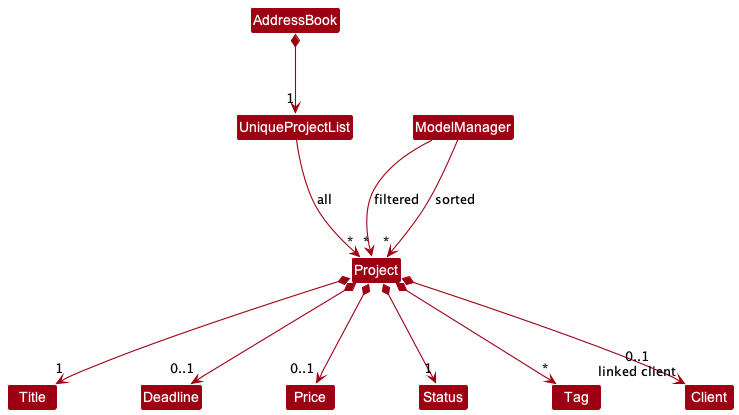
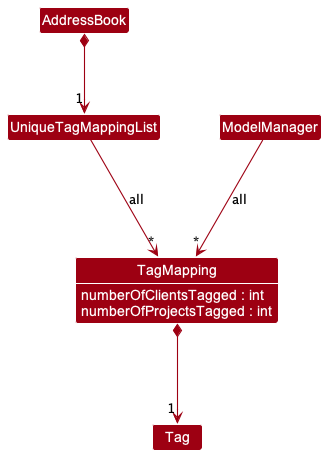
The Model component,
- stores the address book data: all
Clientobjects (which are contained in aUniqueClientListobject), allProjectobjects (which are contained in aUniqueProjectListobject), and allTagMappingobjects (which are contained in aUniqueTagMappingListobject). - stores the currently ‘selected’
Clientobjects (e.g., results of a search query) as a separate filtered list, and stores the currently ‘sorted’Clientobjects (e.g., results of a sort query) as a separate sorted list. Both lists are exposed to outsiders as an unmodifiableObservableList<Client>that can be ‘observed’ e.g. the UI can be bound to this list so that the UI automatically updates when the data in the list changes. - stores the currently ‘selected’
Projectobjects (e.g., results of a search query) as a separate filtered list, and stores the currently ‘sorted’Projectobjects (e.g., results of a sort query) as a separate sorted list. Both lists are exposed to outsiders as an unmodifiableObservableList<Project>that can be ‘observed’ e.g. the UI can be bound to this list so that the UI automatically updates when the data in the list changes. - stores all
TagMappingobjects in a list that is exposed to outsiders as an unmodifiableObservableList<TagMapping> that can be ‘observed’ e.g. the UI can be bound to this list so that the UI automatically updates when the data in the list changes. - stores a
UserPrefobject that represents the user’s preferences. This is exposed to the outside as aReadOnlyUserPrefobject. - does not depend on any of the other three components (as the
Modelrepresents data entities of the domain, they should make sense on their own without depending on other components)
Storage component
API : Storage.java
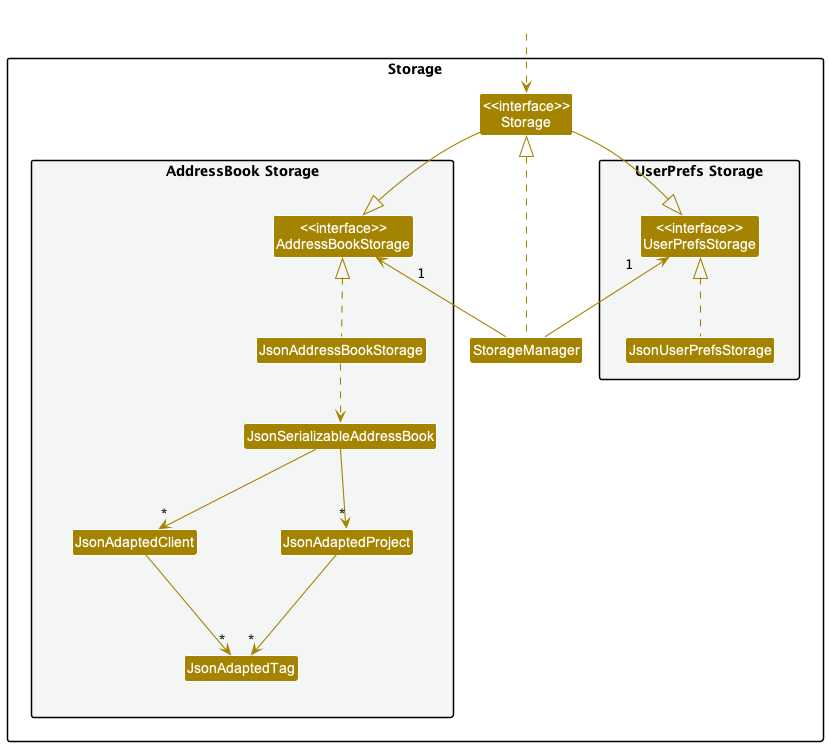
The Storage component,
- can save both address book data and user preference data in json format, and read them back into corresponding objects.
- inherits from both
AddressBookStorageandUserPrefStorage, which means it can be treated as either one (if only the functionality of only one is needed). - depends on some classes in the
Modelcomponent (because theStoragecomponent’s job is to save/retrieve objects that belong to theModel)
Common classes
Classes used by multiple components are in the arb.commons package.
Implementation
This section describes some noteworthy details on how certain features are implemented.
Projects
Implementation
There is a new type of data that can be stored in the application: Projects. These are implemented as a model class, similar to Client. They contain information about the project’s Title, Status, Deadline (optional), and Price(optional), each of which are implemented as separate classes.
A new project can be created using the add-project/ap command by providing necessary and, optionally, optional details of the project. The project can also be edited for any fields, which will create a new project with the updated details to replace the current one. This also means that project details are guaranteed to be immutable.
Each of the project detail classes have their own validation check that is run upon construction of the object, which is done in the parser (specifically, the arb.logic.parser.project.AddProjectCommandParser).
Sorting
Users have the option to sort visible clients and projects.
Implementation
This is facilitated by JavaFX’s SortedList, which sorts its contents based on the supplied Comparator<T>. As mentioned in the model section of the architecture overview, the sorted list is exposed to the UI in the form of an unmodifiable ObservableList, such that any updates to the sorted list is propagated to the UI.
There are a set of Comparators defined inside the ModelManager class, that are supplied to the sorted list depending on how the user wants to sort clients or projects. Example Comparators include comparing names of Client objects.
Whenever the user executes a sort command, the model updates the sorted list with the corresponding Comparator<T>. The below diagram shows what occurs when a user executes a sort-client command, which sorts the client list by name.
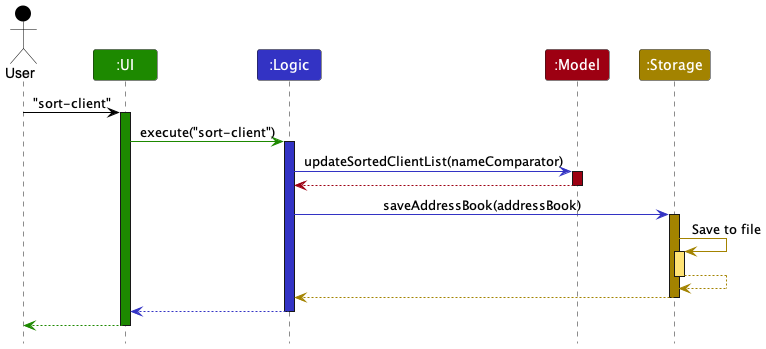
As the contents of the sorted list is the already filtered list, executing sorting will only sort clients/projects that are currently visible. Clients/projects that are hidden due to a previous find command will remain hidden.
Alternatives
An alternative would be for sorting to sort all clients/projects instead of only those that are visible, causing sorting commands to show all clients/projects but sorted. We did not go with this implementation as we wanted users to be able to combine the effects of filtering and sorting for better data organisation.
Linking Projects to Clients
Users have the ability to link projects to clients.
Implementation
When parsing the command to add or edit a project, the parser checks for the existence of client name keywords in the command. If it does, then ArB displays a client list filtered with the provided client name keywords, sets the project to be linked and enters link mode, as shown in the sequence diagram below.
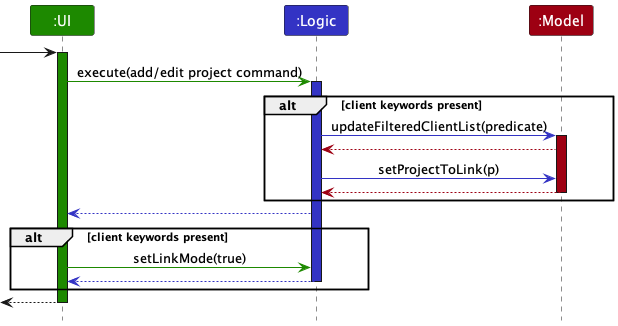
In link mode, the user can input an index to link the added/edited project to the specified client, as shown in the sequence diagram below. ArB will then exit link mode and return to normal operations.
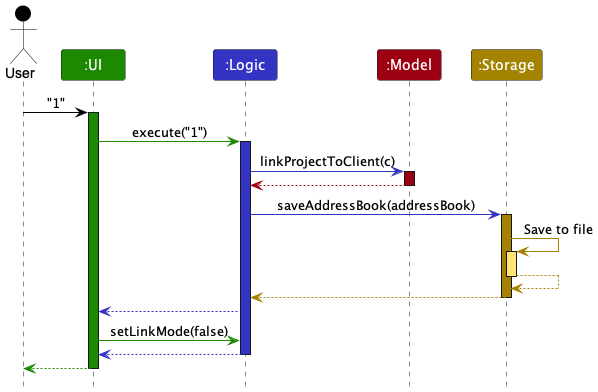
Internally, a project can be linked to one client while a client can have multiple linked projects. A client’s linked projects are stored in a UniqueProjectList object that each Client object has. This implementation is shown in the class diagram below.
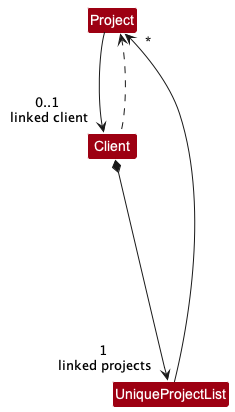
For example, the below is an object diagram representing the situation where we have two projects p1 and p2 that are both linked to the same Client object.
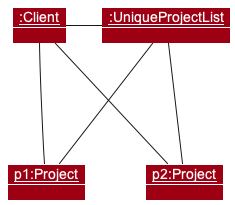
Future improvements
Currently, projects are only allowed to be linked to a single client. This was done to avoid introducing too much complexity such that it was feasible to complete this feature before the deadline.
In future, projects could be linked to multiple clients. This could be implemented by storing a list of Client objects, perhaps using a UniqueClientList. The below class diagram showcases this implementation.
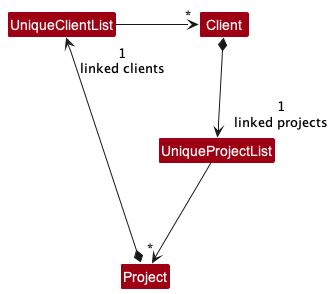
Better filtering
Users now have the ability to find clients and projects using a greater number of parameters, such as tags and deadlines.
Implementation
When parsing find commands, the parser parses each possible parameter one-by-one. For example, users can find clients by name or by tags, so the FindClientCommandParser parses provided names and tags individually into a NameContainsKeywordsPredicate and ClientContainsTagsPredicate that are then combined into a CombinedPredicate object, as shown in the sequence diagram below where the arguments name/Alice tag/friends is parsed.

The CombinedPredicate object c is then used to update the filtered client list, as shown in the sequence diagram below.
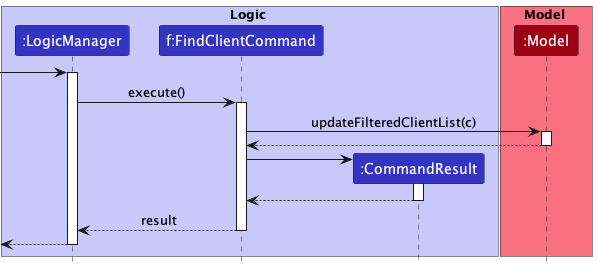
CombinedPredicate<T> is a generic class that inherits from the generic class Predicate<T> and tests all predicates that were passed to it when it was initialised. The FindClientCommand and FindProjectCommand objects are unaware of what predicates it is specifically testing, since they only know that they are testing a Predicate<T> object, making use of the Command design pattern. This is shown by the class diagram below, where a FindClientCommand and FindProjectCommand stores a Predicate<T> object.
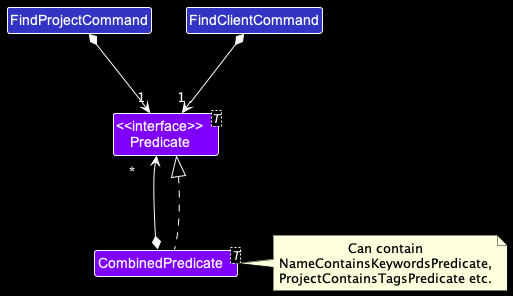
Done Status
Implementation
The displaying of the “DONE” status is facilitated by the markAsDone()
method in the Project class.
The Done status is highlighted in the UI when the project is done.
The ProjectCard class has been updated to run the aforementioned markAsDone()
method for any project before setting its status to OVERDUE, DONE, or NOT DONE.
Not Done Status
Implementation
The displaying of the “NOT DONE” status is facilitated by the markAsUndone()
method in the Project class.
The Not Done status is highlighted in the UI when the project is not done and not overdue.
The ProjectCard class has been updated to run the aforementioned markAsUndone()
method for any project before setting its status to OVERDUE, DONE, or NOT DONE.
Overdue Status
Implementation
The displaying of the “OVERDUE” status is facilitated by the isOverdue method in the Project class. The isOverdue method returns a boolean after using the compareTo method in the Deadline class which checks the current date against the deadline date of the project, i.e. check if a project’s deadline is past the current date.
The Overdue status is highlighted in the UI when any project is past its deadline. The ProjectCard class has been updated to run the aforementioned isOverdue method for any project before setting its status to OVERDUE, DONE, or NOT DONE. The OVERDUE status is shown for existing projects in the list that are overdue, and if a user adds a project with a deadline with a data that has already past.
The below sequence diagram shows how the various components interact with each other when the isOverdue method is run.
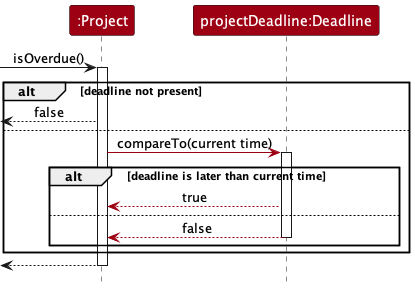
Marking projects
Users have the ability to mark a certain project as DONE.
Implementation
The below sequence diagram shows how the various components interact with each other when mark 1 is entered by the user.
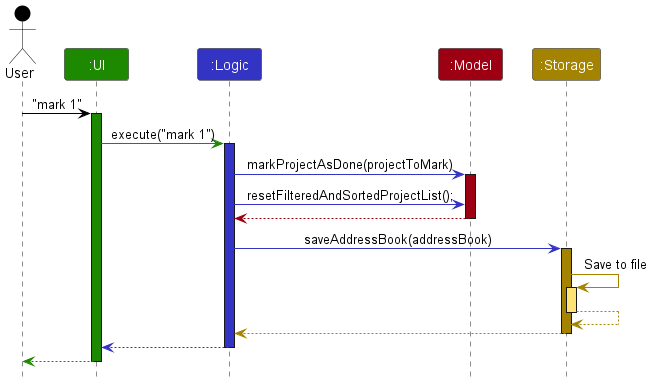
Unmarking projects
Users have the ability to mark a certain project as NOT DONE/OVERDUE.
Implementation
The below sequence diagram shows how the various components interact with each other when unmark 1 is entered by the user.
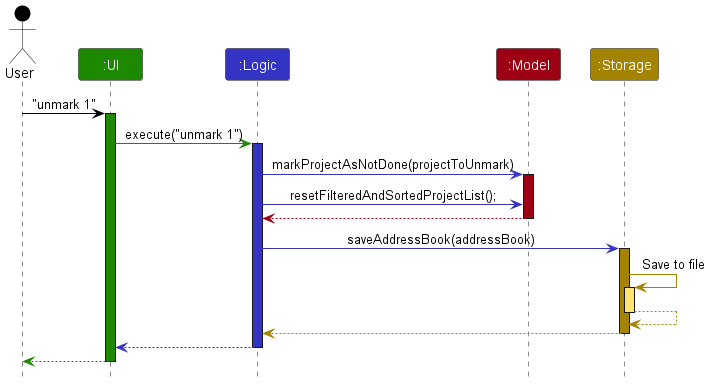
Listing Clients
Users have the ability to list all their clients.
Implementation
The below sequence diagram shows how the various components interact with each other when list-client is entered by the user.
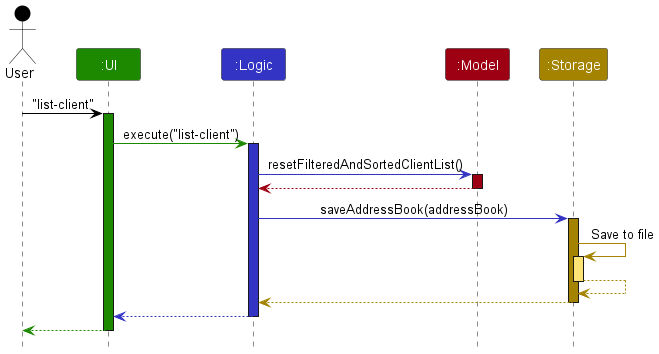
Listing Projects
Users have the ability to list all their projects. A summary of how many OVERDUE, DONE, and NOT DONE projects is also displayed.
Implementation
The below sequence diagram shows how the various components interact with each other when list-project is entered by the user.
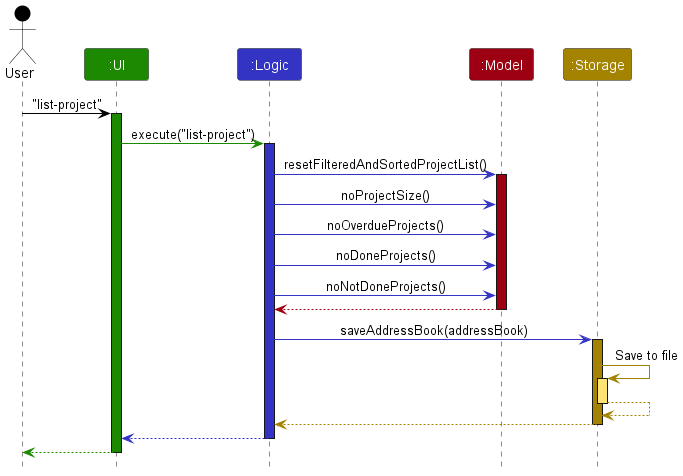
Deleting a Client
Users have the ability to delete a particular client.
Implementation
The sequence diagram shows how the various components interact with each other when delete-client 1 is entered by the user.
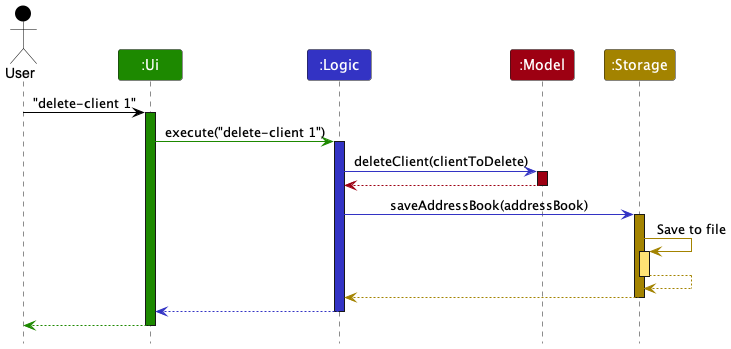
Deleting a Project
Users have the ability to delete a particular project.
Implementation
The sequence diagram shows how the various components interact with each other when delete-project 1 is entered by the user.
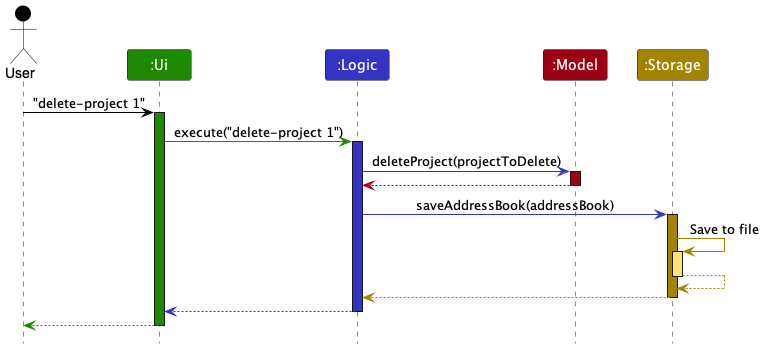
Clearing Clients
Users have the ability to clear all their clients.
Implementation
The below sequence diagram shows how the various components interact with each other when clear-client is entered by the user.
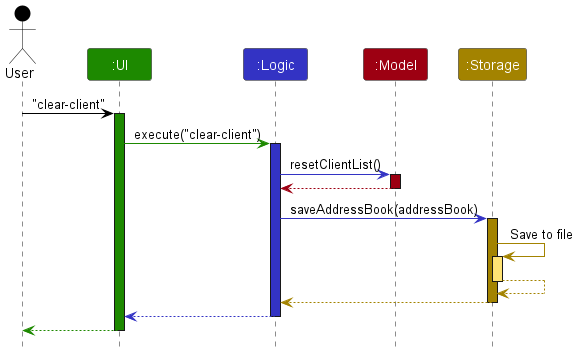
Clearing Projects
Users have the ability to clear all their projects.
Implementation
The below sequence diagram shows how the various components interact with each other when clear-project is entered by the user.
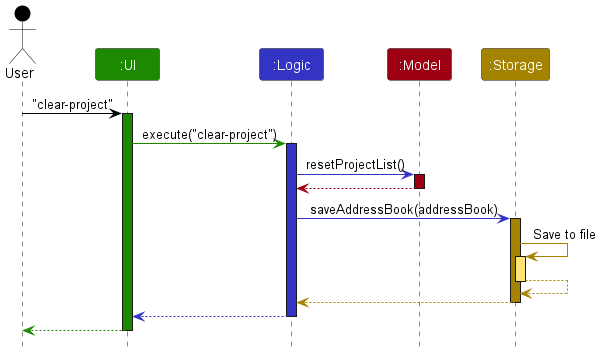
Documentation, logging, testing, configuration, dev-ops
Appendix: Requirements
Product scope
Target user profile:
- has a need to manage a significant number of commission clients
- has a need to manage a significant number of projects
- prefer desktop apps over other types of apps
- can type fast
- prefers typing to mouse interactions
- is reasonably comfortable using CLI apps
Value proposition: manage clients and ongoing projects faster than a typical mouse/GUI driven app
User stories
Priorities: High (must have) - * * *, Medium (nice to have) - * *, Low (unlikely to have) - *
| Priority | As a … | I want to … | So that I can… |
|---|---|---|---|
* * |
artist with many ongoing commissioned projects to keep track of | view my current commissioned projects in order of deadline recency | not miss any deadlines |
* |
artist inexperienced in command line commands | use commands that are closer to natural language | better understand and more effectively use commands |
* * * |
artist | add a deadline to a project | record when a project needs to be done |
* |
artist working with commissions | import a list of clients from a CSV file | use an editable format |
* * |
first-time user of the application | view a guide on how to use the app | learn how to use the app |
* |
artist who wants to increase my earnings | add a large number of commissioned projects at any time | increase my income |
* |
expert in using the application | setup shortcuts for commands I often use | execute them quickly |
* * |
artist who does not want to be overwhelmed by too many ongoing commission projects | quickly see how many ongoing projects I have | deliver for my clients |
* * |
artist | tag clients in the list | filter by the tags if necessary |
* * |
artist | tag projects in the list | filter by the tags if necessary |
* |
inexperienced user | undo commands | remedy mistakes |
* * |
first-time user of the application | see sample data in the application | understand what the application can do |
* * * |
artist | add clients to the application | keep track of all of my clients |
* * * |
artist | remove clients from my list | keep the list accurate |
* * |
artist | edit client info | keep client info up to date in case of changes |
* * |
artist | edit project info | keep project info up to date in case of changes |
* * |
artist who wants to know which of my ongoing projects are most lucrative | quickly sort my ongoing projects based on commission price | prioritize projects with higher commission price |
* * |
artist | add to a project how much money it will make me | know the profit of my projects |
* * |
artist | search for clients using keywords | find specific clients quickly |
* * |
artist ready to start using the application | purge any sample data on the application | start entering my own data onto the application |
* |
artist | quickly see how many times a specific client has commissioned me for a project before | know if clients are returning |
* * |
artist | see how much profit a client has made me so far | know if my relationship with a client is profitable |
* * |
artist | sort clients by how much profit they have made me so far | know which clients are making me the most profit |
* * |
artist | sort clients by the number of times they have commissioned me before | know if a given client and I have a long-standing relationship |
* * * |
artist | add contact info to clients | know how to reach them if needed |
* |
artist | blacklist certain clients | know who to avoid |
* * |
artist | link projects to clients | know what projects are for what clients |
* * |
artist | get asked if I am sure I want to delete an ongoing project | be prevented from accidentally deleting an ongoing project |
* * * |
artist | mark a certain project as done | know it is no longer ongoing |
* |
user | easily generate text to share client information | send it to someone else if required |
* * * |
artist | unmark a project as done | ensure my list is accurate in case I accidentally marked a project as done |
* |
artist | add dates in different formats without being asked to give it in a certain format | not have to memorize providing dates in a certain format |
* * |
busy artist | see all projects due within a specific time period | know what is due at different times and plan my work better |
* |
artist | have the application convert different time zones to my local one and state which country the client is from | add times for clients from various countries and not have to do the conversion myself |
* * |
artist | see all tags I have used | know what tags to use to find clients/projects |
* |
experienced user | directly edit the data file | change stored information without having to open the app |
* * |
artist | find specific clients | see their information |
* * |
artist | find specific projects | see their information |
* * |
artist | search for projects using keywords | find specific projects quickly |
Use cases
(For all use cases below, the System is the Artistic AddressBook, or ArB, and the Actor is the user, unless specified otherwise)
Use case 1 (UC1): Delete a client
MSS
- User requests to list clients.
- ArB shows a list of clients.
- User requests to delete a specific client in the list.
- ArB deletes the client.
Use case ends.
Extensions
- 2a. The list is empty.
Use case ends. - 3a. Provided index is invalid.
- 3a1. ArB shows an error message.
Use case resumes at step 3.
- 3a1. ArB shows an error message.
Use case 2 (UC2): Delete a project
MSS
- User requests to list projects.
- ArB shows a list of projects.
- User requests to delete a specific project in the list.
- ArB deletes the project.
Use case ends.
Extensions
- 2a. The list is empty.
Use case ends. - 3a. Provided index is invalid.
- 3a1. ArB shows an error message.
Use case resumes at step 3.
- 3a1. ArB shows an error message.
Use case 3 (UC3): Mark a project as done
MSS
- User requests to list projects.
- ArB shows a list of projects.
- User requests to mark a specific project in the list as done.
- ArB marks the project as done.
Use case ends.
Extensions
- 2a. The list is empty.
Use case ends. - 3a. Provided index is invalid.
- 3a1. ArB shows an error message.
Use case resumes at step 3.
- 3a1. ArB shows an error message.
Use case 4 (UC4): Unmark a project
MSS
- User requests to list projects.
- ArB shows a list of projects.
- User requests to unmark a specific project in the list.
- ArB unmarks the project.
Use case ends.
Extensions
- 2a. The list is empty.
Use case ends. - 3a. Provided index is invalid.
- 3a1. ArB shows an error message.
Use case resumes at step 3.
- 3a1. ArB shows an error message.
Use case 5 (UC5): List all clients
MSS
- User requests to list clients.
- ArB shows a list of clients.
Use case ends.
Extensions
- 2a. The list is empty.
Use case ends.
Use case 6 (UC6): List all projects
MSS
- User requests to list projects.
- ArB shows a list of projects.
Use case ends.
Extensions
- 2a. The list is empty.
Use case ends.
Use case 7 (UC7): List all tags
MSS
- User requests to list tags.
- ArB shows a list of tags.
Use case ends.
Extensions
- 2a. The list is empty.
Use case ends.
Use case 8 (UC8): Clear all clients
MSS
- User requests to list clients.
- ArB shows a list of clients.
- User requests to clear all clients in the list.
- ArB clears all clients in the list.
Use case ends.
Extensions
- 2a. The list is empty.
Use case ends.
Use case 9 (UC9): Clear all projects
MSS
- User requests to list projects.
- ArB shows a list of projects.
- User requests to clear all projects in the list.
- ArB clears all projects in the list.
Use case ends.
Extensions
- 2a. The list is empty.
Use case ends.
Use case 10 (UC10): Add a client
MSS
- User requests to add a client to the client list, providing ArB with the client’s details.
- ArB adds the client with the specified details to the client list.
Use case ends.
Extensions
- 1a. Provided details are invalid.
- 1a1. ArB shows an error message.
Use case resumes at step 1.
- 1a1. ArB shows an error message.
Use case 11 (UC11): Add a project
MSS:
- User requests to add a project to the project list, providing ArB with the project’s details.
- ArB adds the project to the project list.
Use case ends.
Extensions
- 1a. Provided details are invalid.
- 1a1. ArB shows an error message.
Use case resumes at step 1.
- 1a1. ArB shows an error message.
- 1b. User indicates that they want to link the project to a client.
- 1b1. ArB edits project to use new details.
- 1b2. ArB links the project to a client (UC18).
Use case ends.
Use case 12 (UC12): Edit a client
MSS:
- User selects a client to edit, and provides ArB with the details to edit.
- ArB edits client to use new details.
Use case ends.
Extensions
- 1a. Provided details are invalid.
- 1a1. ArB shows an error message.
Use case ends.
- 1a1. ArB shows an error message.
- 1b. Provided index is invalid.
- 1b1. ArB shows an error message.
Use case ends.
- 1b1. ArB shows an error message.
Use case 13 (UC13): Edit a project
MSS:
- User selects a project to edit, and provides ArB with the details to edit.
- ArB edits project to use new details.
- Use case ends.
Extensions
- 1a. Provided details are invalid.
- 1a1. ArB shows an error message.
Use case ends.
- 1a1. ArB shows an error message.
- 1b. Provided index is invalid.
- 1b1. ArB shows an error message.
Use case ends.
- 1b1. ArB shows an error message.
- 1c. User indicates that they want to link the project to a client.
- 1c1. ArB edits project to use new details.
- 1c2. ArB links the project to a client (UC18).
Use case ends.
Use case 14 (UC14): Find Clients
MSS:
- User requests to find clients, providing ArB with the necessary parameters.
- ArB lists all clients that match the provided parameters.
Use case ends.
Extensions
- 1a. None of the parameters provided are valid.
- 1a1. ArB shows an error message.
Use case ends.
- 1a1. ArB shows an error message.
Use case 15 (UC15): Find Projects
MSS:
- User requests to find projects, providing ArB with the necessary parameters.
- ArB lists all projects that match the provided parameters.
Use case ends.
Extensions
- 1a. None of the parameters provided are valid.
- 1a1. ArB shows an error message.
Use case ends.
- 1a1. ArB shows an error message.
Use case 16 (UC16): Sort Clients
MSS:
- User requests to sort clients.
- ArB sorts all clients by name.
Use case ends.
Use case 17 (UC17): Sort Projects
MSS:
- User requests to sort projects, providing ArB with a necessary parameter.
- ArB sorts all projects based on the provided parameter.
Use case ends.
Extensions
- 1a. The parameter provided is invalid.
- 1a1. ArB shows an error message.
Use case ends.
- 1a1. ArB shows an error message.
Use case 18 (UC18): Link Project To Client
MSS:
- User indicates that they want to link a specific project to a client, providing ArB with client name keywords.
- ArB lists all clients that match the provided client name keywords.
- User selects the client they want to link the project to.
- ArB links the project to the selected client.
Use case ends.
Extensions
- 3a. User chooses to cancel the linking.
Use case ends. - 3b. Provided index is invalid.
- 3b1. ArB shows an error message.
Use case resumes at step 3.
- 3b1. ArB shows an error message.
Non-Functional Requirements
- Should work on any mainstream OS as long as it has Java
11or above installed. - Should be able to hold up to 1000 persons without a noticeable sluggishness in performance for typical usage.
- A user with above average typing speed for regular English text (i.e. not code, not system admin commands) should be able to accomplish most of their tasks faster using commands than using the mouse.
- The final product should be a result of evolving/enhancing/morphing the given code base.
- The product should be targeting users who can type fast and prefer typing over other means of input.
- The product should be for a single user i.e. (not a multi-user product).
- The product needs to be developed in a breadth-first incremental manner over the project duration.
- Data of the product should be stored locally and should be in a human-editable text file.
- The software should not use a DBMS to store data.
- The software should follow the Object-oriented paradigm primarily.
- The software should work on the Windows, Linux, and OS-X platforms.
- The software should work without requiring an installer.
- The software should not depend on our remote server.
- Any third-party frameworks/libraries/services used in the product should be free and open-source (this doesn’t apply to services), have permissive license terms, and should not require any installation by users.
- The GUI of the product should work well (i.e., should not cause any resolution-related inconveniences to the user) for standard screen resolutions 1920x1080 and higher, and for screen scales 100% and 125%.
- The GUI of the product should be usable (i.e., all functions can be used even if the user experience is not optimal) for resolutions 1280x720 and higher, and for screen scales 150%.
- The entire product needs to be packaged into a single JAR file.
- The file sizes of the product should be reasonable and not exceed the limit of 100MB.
- The developer guide and user guide of the product should be PDF-friendly. They shouldn’t use expandable panels, embedded videos, animated GIFs etc.
- The product should be testable.
Glossary
- Mainstream OS: Windows, Linux, OS-X
- Clients: A person who has commissioned the user
- Project: A piece of (art)work to be completed
- Contact info: Email, Phone Number
- Project status: How close to completion a project is
Appendix: Instructions for manual testing
Given below are instructions to test the app manually.
Launch and shutdown
-
Initial launch
-
Download the jar file and copy it into an empty folder.
-
Launch the app using the CLI command
java -jar arb.jar.
Expected: Shows the GUI with a set of sample clients and projects. The window size may not be optimum.
-
-
Saving window preferences
-
Resize the window to an optimum size. Move the window to a different location. Close the window.
-
Re-launch the app using the CLI command
java -jar arb.jar.
Expected: The most recent window size and location is retained.
-
-
Saving data
-
Delete a client from the client list. Close the window.
-
Re-launch the app using the CLI command
java -jar arb.jar.
Expected: The client should remain deleted.
-
Listing all clients
-
Listing all clients while some clients are hidden
-
Filter the client list using the
find-clientcommand such that only some clients are visible. -
Enter the command:
list-client
Expected: All clients shown. Success message shown.
-
-
Listing all clients while viewing another list
-
Show a list other than the client list using either the
list-projectorlist-tagcommands. -
Enter the command:
list-client
Expected: All clients shown. Success message shown.
-
Listing all projects
-
Listing all projects while some projects are hidden
-
Filter the project list using the
find-projectcommand such that only some projects are visible. -
Enter the command:
list-project
Expected: All projects shown. Success message shown.
-
-
Listing all projects while viewing another list
-
Show a list other than the project list using either the
list-clientorlist-tagcommands. -
Enter the command:
list-project
Expected: All projects shown. Success message shown.
-
Listing all tags
-
Listing all tags while viewing another list
-
Show a list other than the tag list using either the
list-clientorlist-projectcommands. -
Enter the command:
list-tag
Expected: All tags shown. Success message shown.
-
Adding a client
-
Specifying all details
- Enter the command:
add-client name/John Doe phone/12345678 email/john@example.com tag/friends
Expected: A client with the specified details added. Details of added client shown in status message.
- Enter the command:
-
Specifying only compulsory details
- Enter the command:
add-client name/David Leong
Expected: Same as previous.
- Enter the command:
-
Adding a duplicate client
-
Add a client by the name
John Doeto the client list. -
Enter the command:
add-client name/John Doe
Expected: Client is not added. Error message shown.
-
Adding a project
-
Specifying all details
- Enter the command:
add-project name/Oil Painting deadline/tomorrow price/500 tag/friends
Expected: A project with the specified details added. Details of added project shown in status message.
- Enter the command:
-
Specifying only compulsory details
- Enter the command:
add-project name/Porcelain Vase
Expected: Same as previous.
- Enter the command:
-
Adding a duplicate project
-
Add a project by the name
Oil Paintingto the project list. -
Enter the command:
add-project name/Oil Painting
Expected: Project is not added. Error message shown.
-
-
Linking added project to client
-
Prerequisites: Add a client by the name
Alice Leongto the client list. Enter the command:add-project name/Clay Cup client/alice
Expected: Details of added project shown in status message. Filtered client list shown. -
Test case:
1
Expected: Success message shown. Added project linked to first client in filtered client list. -
Test case:
0
Expected: Cancel message shown. Added project not linked to any client. -
Test case:
xwhere x is larger than the length of the filtered client list
Expected: Error message shown.
-
Editing a client
-
Editing a client while all clients are being shown
-
Prerequisites: List all clients using the
list-clientcommand. There should be multiple clients in the list. -
Test case:
edit-client 1 name/Jane Doe phone/87654321 email/jane@example.com tag/friends
Expected: First client’s details are edited. Details of edited client shown in status message. -
Test case:
edit-client 0 name/John Doe
Expected: No client is edited. Error details shown in the status message. -
Other incorrect edit commands to try:
edit-client,edit-client x name/John,...(where x is larger than the list size)
Expected: Similar to previous.
-
-
Editing a client while only some clients are shown
-
Prerequisites: Filter the client list using the
find-clientcommand such that only some clients are visible. -
Test case:
edit-client 1 name/Hans phone/12345678 email/hans@example.com tag/friends
Expected: First client’s details are edited. Details of edited client shown in status message. -
Test case:
edit-client 0 name/John Doe
Expected: No client is edited. Error details shown in the status message. -
Test case:
edit-client x name/Johnwhere x is smaller than the entire client list size but is larger than the visible list size
Expected: Similar to previous. -
Other incorrect edit commands to try:
edit-client
Expected: Similar to previous.
-
-
Editing a client while the client list is not being shown
-
Prerequisites: Show a list other than the client list using either the
list-projectorlist-tagcommands. There should be multiple clients in the client list. -
Test case:
edit-client 1 name/John
Expected: No client is edited. Error details shown in the status message.
-
Editing a project
-
Editing a project while all projects are being shown
-
Prerequisites: List all projects using the
list-projectcommand. There should be multiple projects in the list. -
Test case:
edit-project 1 name/Watercolour Drawing deadline/next week price/50 tag/friends
Expected: First project’s details are edited. Details of edited project shown in status message. -
Test case:
edit-project 0 name/Sky Painting
Expected: No project is edited. Error details shown in the status message. -
Other incorrect edit commands to try:
edit-project,edit-project x name/Sky Painting,...(where x is larger than the list size)
Expected: Similar to previous.
-
-
Editing a project while only some projects are shown
-
Prerequisites: Filter the project list using the
find-projectcommand such that only some projects are visible. -
Test case:
edit-project 1 name/Digital Art deadline/next week price/50 tag/friends
Expected: First project’s details are edited. Details of edited project shown in status message. -
Test case:
edit-project 0 name/Sky Painting
Expected: No project is edited. Error details shown in the status message. -
Test case:
edit-project x name/Sky Paintingwhere x is smaller than the entire project list size but is larger than the visible list size
Expected: Similar to previous. -
Other incorrect edit commands to try:
edit-project
Expected: Similar to previous.
-
-
Editing a project while the project list is not being shown
-
Prerequisites: Show a list other than the project list using either the
list-clientorlist-tagcommands. There should be multiple projects in the project list. -
Test case:
edit-project 1 name/Sky Painting
Expected: No project is edited. Error details shown in the status message.
-
-
Linking edited project to client
-
Prerequisites: Add a client by the name
Alice Leongto the client list. Display the project list withlist-project. Enter the command:edit-project 1 client/alice
Expected: Details of edited project shown in status message. Filtered client list shown. -
Test case:
1
Expected: Success message shown. Edited project linked to first client in filtered client list. -
Test case:
0
Expected: Cancel message shown. Edited project not linked to any client. -
Test case:
xwhere x is larger than the length of the filtered client list
Expected: Error message shown.
-
Deleting a client
-
Deleting a client while all clients are being shown
-
Prerequisites: List all clients using the
list-clientcommand. There should be multiple clients in the list. -
Test case:
delete-client 1
Expected: First client is deleted from the client list. Details of the deleted client shown in the status message. -
Test case:
delete-client 0
Expected: No client is deleted. Error details shown in the status message. -
Other incorrect delete commands to try:
delete-client,delete-client x,...(where x is larger than the list size)
Expected: Similar to previous.
-
-
Deleting a client while only some clients are shown
-
Prerequisites: Filter the client list using the
find-clientcommand such that only some clients are visible. -
Test case:
delete-client 1
Expected: First client is deleted from the client list. Details of the deleted client shown in the status message. -
Test case:
delete-client 0
Expected: No client is deleted. Error details shown in the status message. -
Test case:
delete-client xwhere x is smaller than the entire client list size but is larger than the visible list size
Expected: Similar to previous. -
Other incorrect delete commands to try:
delete-client
Expected: Similar to previous.
-
-
Deleting a client while the client list is not being shown
-
Prerequisites: Show a list other than the client list using either the
list-projectorlist-tagcommands. There should be multiple clients in the client list. -
Test case:
delete-client 1
Expected: No client is deleted. Error details shown in the status message. Status bar remains the same.
-
Deleting a project
-
Deleting a project while all projects are being shown
-
Prerequisites: List all projects using the
list-projectcommand. There should be multiple projects in the list. -
Test case:
delete-project 1
Expected: First project is deleted from the project list. Details of the deleted project shown in the status message. Timestamp in the status bar is updated. -
Test case:
delete-project 0
Expected: No project is deleted. Error details shown in the status message. Status bar remains the same. -
Other incorrect delete commands to try:
delete-project,delete-project x,...(where x is larger than the list size)
Expected: Similar to previous.
-
-
Deleting a project while only some projects are shown
-
Prerequisites: Filter the project list using the
find-projectcommand such that only some projects are visible. -
Test case:
delete-project 1
Expected: First project is deleted from the project list. Details of the deleted project shown in the status message. Timestamp in the status bar is updated. -
Test case:
delete-project 0
Expected: No project is deleted. Error details shown in the status message. Status bar remains the same. -
Test case:
delete-project xwhere x is smaller than the entire project list size but is larger than the visible list size
Expected: Similar to previous. -
Other incorrect delete commands to try:
delete-project
Expected: Similar to previous.
-
-
Deleting a project while the project list is not being shown
-
Prerequisites: Show a list other than the project list using either the
list-clientorlist-tagcommands. There should be multiple projects in the project list. -
Test case:
delete-project 1
Expected: No project is deleted. Error details shown in the status message. Status bar remains the same.
-
Finding clients
-
Finding clients
-
Prerequisites: Add a client by the name of
Alice Limto the client list. -
Test case:
find-client name/Alice
Expected: Client list with at least one client is shown. Status message states how many clients were found. -
Test case:
find-client
Expected: Error message is shown.
-
Finding projects
-
Finding projects
-
Prerequisites: Add a project by the name of
Crayon Drawingto the project list. -
Test case:
find-project name/crayon
Expected: Project list with at least one project is shown. Status message states how many projects were found. -
Test case:
find-project
Expected: Error message is shown.
-
Sorting clients
-
Sorting clients when entire client list is shown
-
Prerequisites: Client list should have multiple clients.
-
Test case:
sort-client
Expected: Client list is sorted by name. Status message states that client list was sorted.
-
-
Sorting clients when some clients are hidden
-
Prerequisites: Filter the client list with the
find-clientcommand. Client list should have multiple clients. -
Test case:
sort-client
Expected: Visible clients are sorted by name. Status message states that client list was sorted.
-
Sorting projects
-
Sorting projects when entire project list is shown
-
Prerequisites: Project list should have multiple projects.
-
Test case:
sort-project option/name
Expected: Project list is sorted by name. Status message states that project list was sorted.
-
-
Sorting projects when some projects are hidden
-
Prerequisites: Filter the project list with the
find-projectcommand. Project list should have multiple projects. -
Test case:
sort-project option/name
Expected: Visible projects are sorted by name. Status message states that project list was sorted.
-
Editing the data file
-
Dealing with missing/corrupted data files
-
Test case: delete the data file
Delete the JSON file in thedatafolder that is found in the same folder as the jar file. Launch the app.
Expected: Status message should state that a data file could not be found. The app should be filled with sample data. -
Test case: corrupt the data file
Open the JSON file and delete thenameattribute of a client before launching the app.
Expected: Status message should state that the data file was not in the correct format. The app should start with no data.
-
-
Correctly editing the data file
-
Test case: Change the name attribute of a client to another valid value such as
Davidbefore launching the app
Expected: Status message should state that the data file was found, and the app should reflect the edited data. -
Other edits to try: Editing other attributes such as phone number
Expected: Similar to previous.
-
Appendix: Effort
Difficulty Level
- The project was moderately challenging. The initial code base was quite large and complicated. It took us some time to fully understand it and how each component interacted, especially considering there were frameworks used that our team did not have any experience with, such as JavaFX.
- It took longer to get started on implementing some of our features because we had to decide on the internal structure and how we wanted to proceed considering there was no one best way to do things. We had to come up with solutions that did not introduce too much complexity and was feasible within the deadline but still delivered the functionality we wanted.
Challenges Faced
- Understanding how FXML worked and its syntax. It took a long time and much research to be able to modify the existing user interface to match our new design.
- Getting started with PlantUML to create diagrams for the updated developer guide required a fair amount of troubleshooting.
- Making one change often resulted in a cascade of other changes that needed to be made, which hindered our progress initially while we familiarised ourselves with the code base.
Effort Required
- A lot of time to implement natural language processing for parsing deadlines was saved by using the PrettyTime library, since it already implements natural language processing. Our work on this can be found in the class Deadline.java.
- Implementing the new Project-related classes took some deliberation and time but was overall not particularly difficult.
- Some commands such as add, edit, delete had similar implementations for the projects as the initial person commands so could be adapted with ease. However, the new features such as find and sort took a bit more thought.
Achievements
- Creating a set of new structures to model the Project class in our own way.
- Our product manages three entities, two of which have to interact with each other, compared to AB3, which only manages one entity.
Appendix: Planned Enhancements
- Error messages for invalid indexes are vague, sometimes stating
Invalid command format!orThe index provided is invalid. In future, we can display clearer error messages corresponding to each case:- Index provided is not a number:
The index you provided was not a number! Index must be a positive number, e.g. 1, 2, 3... - Index provided is not a positive number:
The index you provided was not a positive number! Index must be a positive number, e.g. 1, 2, 3... - Index provided is larger than the currently visible list:
The index you provided was larger than the currently visible list!
- Index provided is not a number:
- The client list and project list are not displayed together, which can inconvenience users as they have to constantly switch between the lists with additional commands. This especially makes it difficult for users to link projects to clients since they are unable to see what clients are available to link to when editing projects.
- The client and project list could be displayed on one screen, with special care taken to ensure that the size of the information never becomes too small.
- Checking for duplicate client names is not case-sensitive. However, most people consider
aliceandAliceto be the same person and may inputaliceintending for the name to beAlice.- Parsing for client names should be made insensitive. User input for names should be parsed to title case e.g.
alice leongis parsed toAlice Leong, as shouldnameattributes in the JSON file.
- Parsing for client names should be made insensitive. User input for names should be parsed to title case e.g.